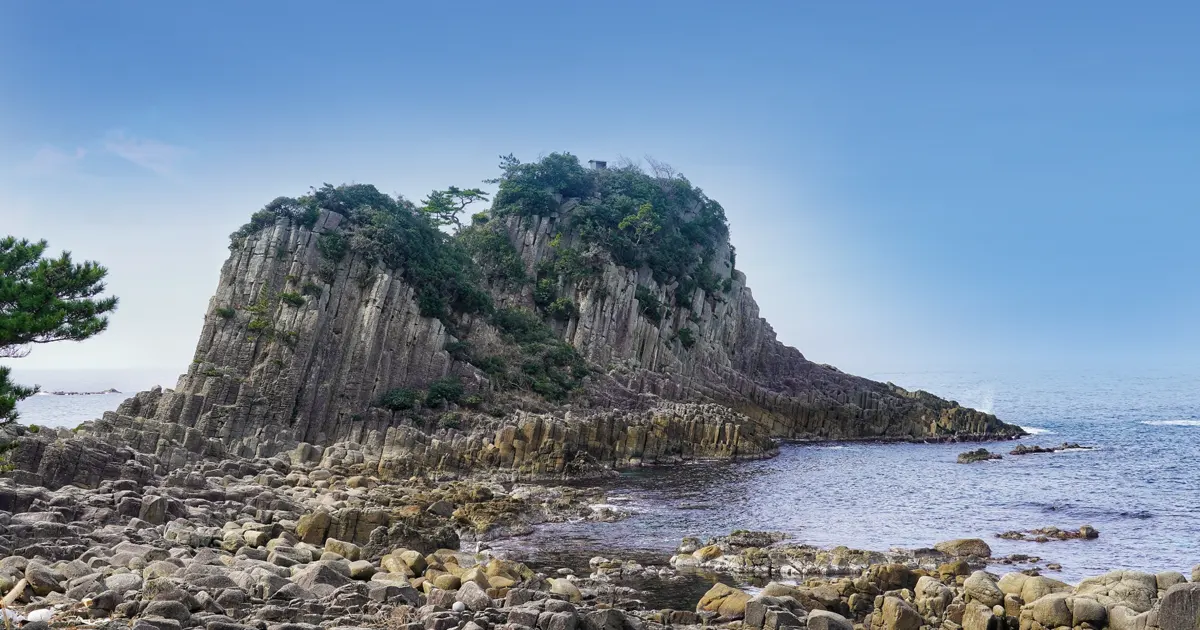Cliffs rising sharply against the deep blue of the Sea of Japan —that is Hokojima , a small rocky island along the coast of Fukui City. The columnar joints formed by volcanic activity look like natural sculptures, quietly welcoming visitors who make their way here.
This article introduces Hokojima’s highlights, suggested time for a visit, and practical tips to help you enjoy your trip with ease. Whether you are traveling alone or visiting Japan for the first time, the information is designed to give you confidence.
Why not add this scenic spot to your journey? Here we share the unique charm of Hokojima in detail.
Contents
Hokojima Access Guide for First-time Visitors
Check the latest weather forecast before your visit: [weathernews ]
By Train
Fukui Station
From JR Fukui Station, take the Keifuku Bus “Ayukawa Line” and get off at “Hokojima” bus stop (about 50 minutes)
A short walk from the bus stop
Total travel time: about 1 hour
Kanazawa Station
Take the JR Hokuriku Main Line Limited Express to Fukui Station (about 40 minutes)
From JR Fukui Station, take the Keifuku Bus “Ayukawa Line” and get off at “Hokojima” bus stop (about 50 minutes)
A short walk from the bus stop
Total travel time: about 1 hour 40 minutes
One Point Advice
Hokojima Visitor Information: Hours & Admission
Admission: Free
Hours: Open for visits at any time
Closed: None
Official Travel Guide: https://fuku-iro.jp/
Hokojima Highlights & Half-day Plan
Columnar Cliffs|Nature’s Stone Art
The most striking feature of Hokojima is the columnar joint cliffs created by volcanic activity. The towering rows of rock look like giant stone pillars, allowing you to feel both the strength and beauty of nature. Walking along the path, you hear the waves crashing against the cliffs and experience the Sea of Japan with all your senses. Visitors are often captivated by the intricate formations, remembering them as “stone art” crafted by nature along the Japanese coastline.
Time required: 20–30 minutes
Admission: Free
Hilltop Shrine & Jizo|Prayers for Safe Seas
At the top of the island, a small shrine and Jizo statues have long been worshiped by local fishermen and sailors. Reaching them via a steep path, you encounter a symbolic scene where rugged nature and human prayers meet. It remains both a sightseeing spot and a place of faith, where travelers often pause to offer a wish for safe passage . For those interested in history and culture, Hokojima holds a special meaning.
Time required: 15–20 minutes
Admission: Free
Sunset & Starry Sky|Best Evening View
While the cliffs are impressive during the day, Hokojima is at its most spectacular from evening into night. The sunset turns the horizon crimson, and after dusk the lack of artificial lights reveals a sky filled with stars. From summer to autumn, the Milky Way can be seen with the naked eye, making this Japanese coastal spot an excellent location for night photography. Even a short visit becomes more rewarding if you stay to see the shift from day to evening.
Time required: 30–40 minutes
Admission: Free
Hokojima Nearby Trips|Afternoon & Next Day
Echizen Matsushima Aquarium|Marine Life Encounters (Walk)
Within walking distance of Hokojima, Echizen Matsushima Aquarium offers interactive experiences with sea creatures. Events include meeting dolphins and seals, as well as walking across glass tanks with fish swimming below. Stopping by after a visit to Hokojima provides a different way to enjoy the richness of the Sea of Japan.
Tojinbo|Dramatic Sea Cliffs (Train + Bus)
About one hour from Hokojima via Fukui Station by train and bus, Tojinbo is one of Japan’s most famous cliff formations. Rising more than 20 meters high, the jagged walls shaped by rough waves are truly overwhelming. A sightseeing boat also operates here, giving you the chance to view the cliffs dramatically from the sea. Visiting both Hokojima and Tojinbo offers a full appreciation of the natural beauty of the Echizen coas t, one of Japan’s most popular coastal sightseeing areas.
Eiheiji Temple|Zen Sanctuary (Next Day)
Recommended for the following day is Eiheiji Temple , the head temple of the Soto Zen sect, located outside Fukui City. Surrounded by towering cedar trees, the temple complex is still home to monks engaged in daily training. Walking among its solemn halls offers a quiet, spiritual experience, contrasting with the power of nature seen at Hokojima. Visiting Eiheiji after Hokojima adds a sense of inner peace to your journey.
Hokojima Travel Q&A
How much time should I plan for a visit?
A 30–40 minute stay is enough to walk the island and take photos at this Japanese scenic spot.
Is it suitable for children and elderly visitors?
The path is maintained, but there are some steps. Comfortable shoes are recommended.
Where are the best photo spots at Hokojima?
The bridge on the walking path and the view from the hilltop overlooking the cliffs and the Sea of Japan are the most popular.
What is the best season or time to visit?
From autumn to winter, sunsets and starry skies are especially beautiful, while daytime highlights the blue sea against the rock formations.
What local food can I enjoy along with a visit to Hokojima?
Dishes featuring fresh seafood, such as Echizen crab and sashimi bowls, are specialties of the region.
Hokojima Travel Summary & Next Steps
Hokojima is a unique Japanese natural site where you can experience the dramatic cliffs and the Sea of Japan up close. Though it requires only a short stop, the sunsets and starry skies leave a lasting impression.
Access is relatively simple, and with Admission: Free it is easy to include in your travel plans. Walking the paths and visiting the shrine allows you to feel both the power of nature and the quiet of history.
Next, why not continue along the Echizen coast and visit the famous cliffs of Tojinbo?

